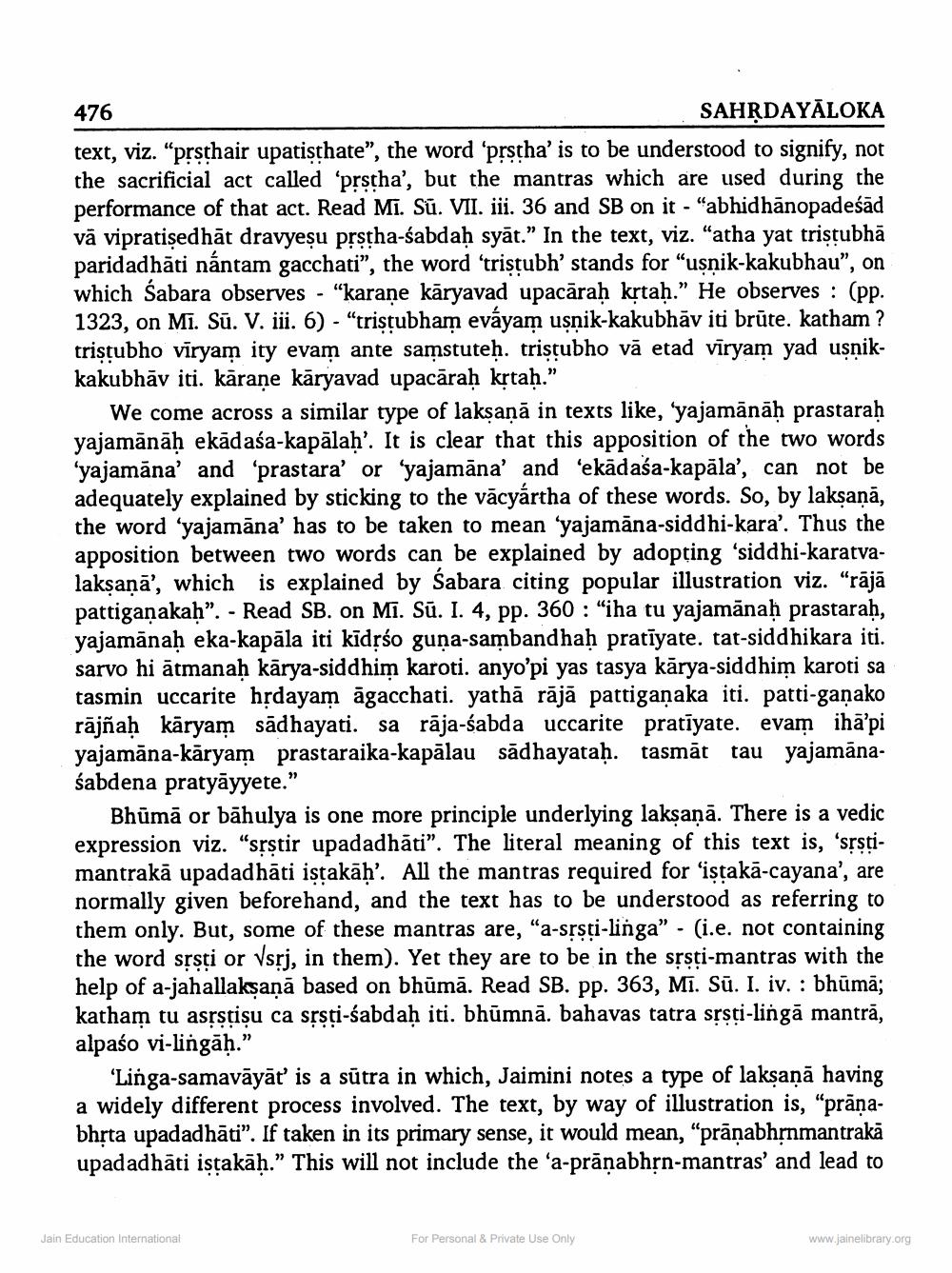________________
476
SAHRDAYĀLOKA text, viz. “prsthair upatișthate”, the word 'prstha' is to be understood to signify, not the sacrificial act called 'prstha', but the mantras which are used during the performance of that act. Read Mi. Sū. VII. iii. 36 and SB on it - "abhidhānopadeśād vā vipratisedhāt dravyesu prstha-śabdah syāt.” In the text, viz. "atha yat tristubha paridadhāti nántam gacchati”, the word 'tristubh' stands for “usņik-kakubhau”, on which Śabara observes - "karane kāryavad upacāraḥ kṣtah.” He observes : (pp. 1323, on Mi. Sū. V. iii. 6) - "tristubham eváyam usnik-kakubhāv iti brūte. katham ? tristubho vīryam ity evam ante samstuteḥ. tristubho vā etad vīryam yad uşņikkakubhāv iti. kāraṇe kāryavad upacāraḥ krtah.”
We come across a similar type of laksaņā in texts like, 'yajamānāḥ prastaraḥ yajamānāh ekādaśa-kapālah'. It is clear that this apposition of the two words 'yajamāna' and 'prastara' or 'yajamāna' and 'ekādaśa-kapāla', can not be adequately explained by sticking to the vācyártha of these words. So, by lakṣaṇā, the word 'yajamāna' has to be taken to mean 'yajamāna-siddhi-kara'. T apposition between two words can be explained by adopting 'siddhi-karatvalaksanā', which is explained by Sabara citing popular illustration viz. “rājā pattiganakah”. - Read SB. on Mi. Sū. I. 4, pp. 360 : “iha tu yajamānaḥ prastaraḥ, yajamānah eka-kapāla iti kidrśo guna-sambandhah pratīyate. tat-siddhikara iti. sarvo hi ātmanah kārya-siddhim karoti. anyo'pi yas tasya kārya-siddhim karoti sa tasmin uccarite hrdayam agacchati. yathā rājā pattiganaka iti. patti-gañako rājñaḥ kāryam sādhayati. sa rāja-śabda uccarite pratīyate. evam ihā’pi yajamāna-kāryam prastaraika-kapālau sādhayataḥ. tasmāt tau yajamānaśabdena pratyāyyete.
Bhūmā or bāhulya is one more principle underlying lakṣaṇā. There is a vedic expression viz. "srstir upadadhāti”. The literal meaning of this text is, 'srstimantrakā upadadhāti istakāḥ'. All the mantras required for 'istakā-cayana', are normally given beforehand, and the text has to be understood as referring to them only. But, some of these mantras are, “a-srsti-linga” - (i.e. not containing the word srsti or Vsrj, in them). Yet they are to be in the srsti-mantras with the help of a-jahallaksaņā based on bhūmā. Read SB. pp. 363, Mi. Sū. I. iv. : bhūmā; katham tu asrstisu ca srsti-sabdah iti. bhūmnā. bahavas tatra srsti-lingā mantrā, alpaśo vi-lingāḥ.”
'Linga-samavāyāt' is a sūtra in which, Jaimini notes a type of laksaņā having a widely different process involved. The text, by way of illustration is, “prāņabhỉta upadadhāti”. If taken in its primary sense, it would mean, “prāṇabhịnmantrakā upadadhāti istakāḥ.” This will not include the 'a-prāṇabhỉn-mantras' and lead to
Jain Education International
For Personal & Private Use Only
www.jainelibrary.org




